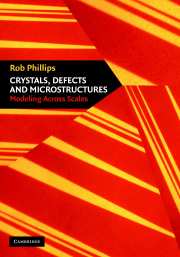Book contents
- Frontmatter
- Contents
- Preface
- Acknowledgements
- Notes on Units, Scales and Conventions
- Part One Thinking About the Material World
- Part two Energetics of Crystalline Solids
- Part three Geometric Structures in Solids: Defects and Microstructures
- Part four Facing the Multiscale Challenge of Real Material Behavior
- References
- Index
Preface
Published online by Cambridge University Press: 29 October 2009
- Frontmatter
- Contents
- Preface
- Acknowledgements
- Notes on Units, Scales and Conventions
- Part One Thinking About the Material World
- Part two Energetics of Crystalline Solids
- Part three Geometric Structures in Solids: Defects and Microstructures
- Part four Facing the Multiscale Challenge of Real Material Behavior
- References
- Index
Summary
Materials science as a formal discipline has quietly emerged as one of the central pillars of the physical sciences. Whether one interests oneself in the creation of lighter, more durable surfboards, or in the invention of new technologies to free up the traffic jam on the world wide web, in the end, these questions will always imply demands which must be met by new classes of materials.
Though the study of materials is largely rooted in the enlightened empiricism of traditional metallurgy, the advent of high-speed computers and the emergence of robust quantum simulations suggests new engineering strategies in which mechanism-based understanding might be hoped to lead to new materials. As a result of the maturation of theoretical materials science, it has become increasingly possible to identify a corpus of central results which serve as the basis for the analysis of materials. In addition, increasingly complex materials with structures at many different scales have led to the emergence of methods built around the explicit consideration of multiple scales simultaneously. As a result of these advances, this book attempts to take stock of the present capacity for modeling materials, with the word modeling used in the broadest sense.
The book is divided into four basic parts. It opens with an overview of some of the key issues concerning materials that one might hope to succeed in modeling. Special reference is made to the notion of material parameters as characterized by the broad variety of data about materials that may be found in any databook. Though my comments on material response will be rather generic, my efforts to model such response will be restricted almost exclusively to crystalline solids.
- Type
- Chapter
- Information
- Crystals, Defects and MicrostructuresModeling Across Scales, pp. xv - xxPublisher: Cambridge University PressPrint publication year: 2001
- 5
- Cited by



